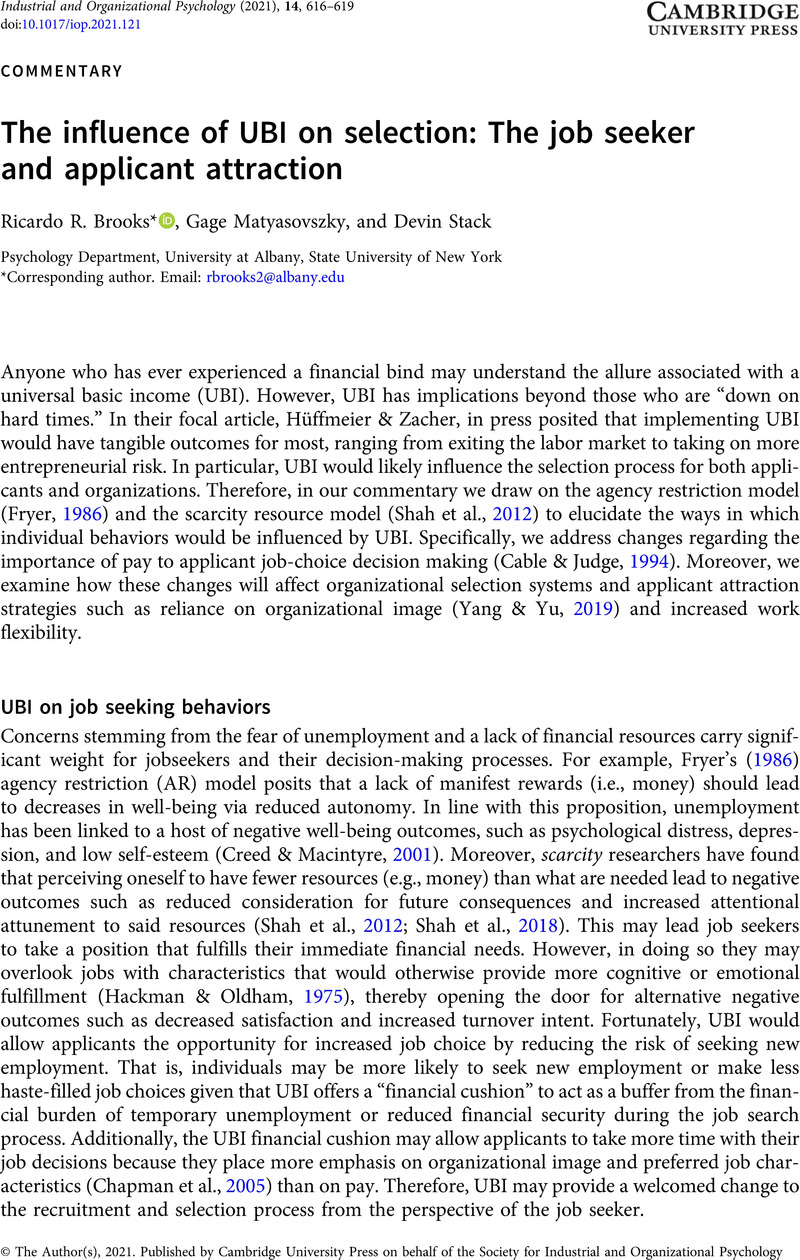No CrossRef data available.
Article contents
The influence of UBI on selection: The job seeker and applicant attraction
Published online by Cambridge University Press: 14 December 2021
Abstract
An abstract is not available for this content so a preview has been provided. Please use the Get access link above for information on how to access this content.

- Type
- Commentaries
- Information
- Copyright
- © The Author(s), 2021. Published by Cambridge University Press on behalf of the Society for Industrial and Organizational Psychology
References
Ashford, S. J., Caza, B. B., & Reid, E. M. (2018). From surviving to thriving in the gig economy: Aresearch agenda for individuals in the new world of work. Research in Organizational Behavior, 38, 23–41.10.1016/j.riob.2018.11.001CrossRefGoogle Scholar
Blanchflower, D. G., & Oswald, A. J. (1998). What makes an entrepreneur? Journal of Labor Economics, 16(1), 26–60.10.1086/209881CrossRefGoogle Scholar
Cable, D. M., & Judge, T. A. (1994). Pay preferences and job search decisions: Aperson–organization fit perspective. Personnel Psychology, 47(2), 317–348.10.1111/j.1744-6570.1994.tb01727.xCrossRefGoogle Scholar
Caliendo, M., Fossen, F. M., & Kritikos, A. S. (2009). Risk attitudes of nascent entrepreneurs: New evidence from an experimentally validated survey. Small Business Economics, 32(2), 153–167.10.1007/s11187-007-9078-6CrossRefGoogle Scholar
Chapman, D. S., Uggerslev, K. L., Carroll, S. A., Piasentin, K. A., & Jones, D. A. (2005). Applicant attraction to organizations and job choice: Ameta-analytic review of the correlates of recruiting outcomes. Journal of Applied Psychology, 90(5), 928–944.10.1037/0021-9010.90.5.928CrossRefGoogle ScholarPubMed
Creed, P. A., & Macintyre, S. R. (2001). The relative effects of deprivation of the latent and manifest benefits of employment on the well-being of unemployed people. Journal of Occupational Health Psychology, 6(4), 324–331.10.1037/1076-8998.6.4.324CrossRefGoogle ScholarPubMed
Eckhardt, J. T., & Shane, S. (2010). An update to the individual-opportunity nexus. In Ács Zoltán, J. & Audretsch, D. B. (Eds.), Handbook of entrepreneurship research: An interdisciplinary survey and introduction (2nd ed., Vol. 5, pp. 47–76). Springer.10.1007/978-1-4419-1191-9_3CrossRefGoogle Scholar
Fryer, D. (1986). Employment deprivation and personal agency during unemployment: Acritical discussion of Jahoda’s explanation of the psychological effects of unemployment. Social Behaviour, 1(1), 3–23.Google Scholar
Gagné, M., & Deci, E. L. (2005). Self-determination theory and work motivation. Journal of Organizational behavior, 26(4), 331–362.10.1002/job.322CrossRefGoogle Scholar
Gifford, S. (2011). Risk and Uncertainty. In Ács Zoltán, J. & Audretsch, D. B. (Eds.), Handbook of entrepreneurship research: An interdisciplinary survey and introduction (2nd ed., Vol. 5, pp. 303–318). Springer.Google Scholar
Hackman, J. R., & Oldham, G. R. (1975). Development of the Job Diagnostic Survey. Journal of Applied Psychology, 60(2), 159–170.10.1037/h0076546CrossRefGoogle Scholar
Huang, N., Burtch, G., Hong, Y., & Pavlou, P. A. (2020). Unemployment and worker participation in the gig economy: Evidence from an online labor market. Information Systems Research, 31(2), 431–448.10.1287/isre.2019.0896CrossRefGoogle Scholar
Hüffmeier, J., & Zacher, H. (in press). The basic income: Initiating the needed discussion in industrial, work, and organizational psychology. Industrial and Organizational Psychology: Perspectives on Science and Practice.Google Scholar
Jurgensen, C. E. (1978). Job preferences (what makes a job good or bad?). Journal of Applied Psychology, 63(3), 267–276.10.1037/0021-9010.63.3.267CrossRefGoogle Scholar
Koudstaal, M., Sloof, R., & van Praag, M. (2014). Risk, uncertainty, and entrepreneurship: Evidence from a lab-in-the-field experiment. Tinbergen Institute Discussion Paper, TI 2014-136/VII. http://papers.tinbergen.nl/14136.pdf.Google Scholar
Lievens, F., & Highhouse, S. (2003). The relation of instrumental and symbolic attributes to a company’s attractiveness as an employer. (2003). Personnel Psychology, 56(1), 75–102.10.1111/j.1744-6570.2003.tb00144.xCrossRefGoogle Scholar
Newman, A., Obschonka, M., Schwarz, S., Cohen, M., & Nielsen, I. (2019). Entrepreneurial self-efficacy: Asystematic review of the literature on its theoretical foundations, measurement, antecedents, and outcomes, and an agenda for future research. Journal of Vocational Behavior, 110 Part B(February), 403–419.10.1016/j.jvb.2018.05.012CrossRefGoogle Scholar
Osborn, D. P. (1990). A reexamination of the organizational choice process. Journal of Vocational Behavior, 36(1), 45–60.10.1016/0001-8791(90)90014-SCrossRefGoogle Scholar
Palich, L. E., & Bagby, D. R. (1995). Using cognitive theory to explain entrepreneurial risk-taking: Challenging conventional wisdom. Journal of Business Venturing, 10(6), 425–438.10.1016/0883-9026(95)00082-JCrossRefGoogle Scholar
Rynes, S. L. (1987). Compensation strategies for recruiting. Topics in Total Compensation, 2(2), 185–196.Google Scholar
Rynes, S. L., Schwab, D. P., & Heneman, H. G., III. (1983). The role of pay and market pay variability in job application decisions. Organizational Behavior and Human Performance, 31(3), 353–364.10.1016/0030-5073(83)90130-7CrossRefGoogle Scholar
Shah, A. K., Mullainathan, S., & Shafir, E. (2012). Some consequences of having too little. Science, 338(6107), 682–685.10.1126/science.1222426CrossRefGoogle ScholarPubMed
Shah, A. K., Zhao, J., Mullainathan, S., & Shafir, E. (2018). Money in the mental lives of the poor. Social Cognition, 36(1), 4–19.10.1521/soco.2018.36.1.4CrossRefGoogle Scholar
Statista Research Department. (2021, May 11). Leading reasons for freelancing U.S. 2020. https://www.statista.com/statistics/530887/top-ten-reasons-for-freelance-work-us/.Google Scholar
Slaughter, J. E., Zickar, M. J., Highhouse, S., & Mohr, D. C. (2004). Personality trait inferences about organizations: Development of a measure and assessment of construct validity. Journal of Applied Psychology, 89(1), 85–103.10.1037/0021-9010.89.1.85CrossRefGoogle ScholarPubMed
Yang, K., & Yu, T. (2019). Influencing how one is seen by potential talent: Organizational impression management among recruiting firms. Journal of Applied Psychology, 104(7), 888–906.Google Scholar




